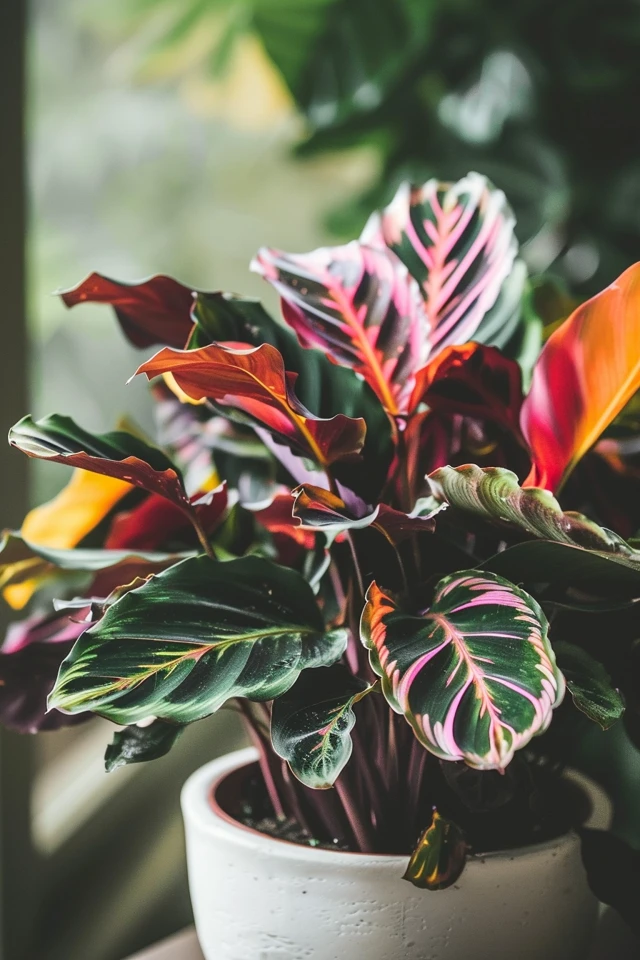Propagating Calathea plants through division is a simple and effective way to expand your plant collection or share with others. Calathea plants can quickly outgrow their pots and become rootbound, so dividing them allows for healthier plants with more space to grow. The best time to propagate Calathea plants is in early spring, before the plant begins its new growth cycle.
To propagate, you will need new pots with drainage holes, potting soil, a sharp knife for clean cuts, a trowel for filling pots, and a watering can with room temperature water. Follow these steps for successful Calathea plant division:
- Water your plants well the day before dividing to loosen the soil.
- Fill new pots one-third of the way with potting mix.
- Gently remove the Calathea plant from its pot and brush away loose soil.
- Look for natural divisions in the roots, usually around stem clusters.
- Gently separate the roots with your fingers, avoiding cutting unless necessary.
- Trim any damaged or diseased roots.
- Place the new plant in a pot, letting the roots dangle down the sides of the soil mound.
- Fill the pot with soil and water until it begins to seep out of the drainage holes.
- Cover the new plant with a plastic bag until new growth appears.
Key Takeaways:
- Propagating Calathea plants through division allows for healthier plants and more space to grow.
- The best time to propagate Calathea plants is in early spring.
- Prepare new pots with drainage holes, potting soil, and necessary tools before propagating.
- Water your plants well the day before dividing to loosen the soil.
- Gently separate the roots and trim any damaged or diseased roots.

Best Practices for Calathea Plant Propagation
When propagating Calathea plants, it is important to provide ideal care to help the newly propagated plants adjust and settle into their new homes. Here are some best practices to ensure successful Calathea plant propagation:
- Calathea Plant Care: Calathea plants prefer indirect sunlight, so it is best to keep them away from direct sunlight to prevent leaf burn. Find a bright spot in your home where they can receive filtered light.
- Calathea Plant Splitting Techniques: Water the newly propagated plants when the top layer of soil is barely damp. Avoid overwatering, as Calathea plants are susceptible to root rot. Gradually return to regular watering after a couple of weeks.
- Calathea Plant Propagation Guide: These plants thrive in humid conditions. Consider providing humidity using methods such as misting the leaves, placing a plastic cover over the new plant, using a pebble tray, or using a humidifier. Maintaining humidity will help prevent leaf curling and browning.
Nitrogen Fertilizer:
Nitrogen fertilizer can encourage growth and maintain well-patterned foliage. However, use a half-strength mixture on small, young divisions every two weeks to once a month to prevent fertilizer burn.Transplanting Divisions:
Transplant the divisions to separate pots when they start to put on new growth or when the current container becomes overcrowded. The best time to repot Calathea divisions is in the spring. Fill the new pots with high-quality potting soil and water the roots well.
“By following these best practices, you can ensure the successful propagation of your Calathea plants. Providing the right care, light, humidity, and nutrients will help the newly propagated plants thrive and grow into beautiful specimens.”

Tips for Propagating Calathea Plants Successfully
If you want to expand your collection of Calathea plants or share them with others, propagating them through division is an effective method. To ensure successful propagation, follow these helpful tips:
1. Make sure the mother plant is large enough to provide adequate roots for each new plant. This will ensure the new divisions have a good chance of thriving.
2. It is best to propagate Calathea plants through division rather than other methods like cuttings or air layering. Dividing the plants allows for healthy growth and development.
3. When potting the newly divided plants, use containers with moist, loose, well-draining soil. This will promote optimal root growth and prevent waterlogged conditions.
4. Ensure the plants have enough space to grow by using pots that are 1-2 inches larger in diameter than the root ball. This will give the roots ample room to spread and establish themselves.
5. Water the newly potted plants and place them in an area with medium indirect light. Avoid direct sunlight, as it can cause leaf burn and stress the young plants.
6. Calathea plants thrive in humid conditions, so provide consistent humidity by misting the plants or using other methods such as a pebble tray or humidifier.

7. Use a nitrogen fertilizer to encourage growth and maintain well-patterned foliage. Apply the fertilizer at half-strength to small, young divisions every two weeks to once a month.
8. Gradually acclimate the plants to brighter conditions as they mature. This will help them adjust and thrive in their new environment.
9. Repot the divisions when they outgrow their current containers. Look for roots emerging from the drainage holes or when the top growth becomes too big. This will ensure the plants have enough space to continue growing.
10. Lastly, remember to follow proper watering and feeding practices to support the growth and development of the propagated Calathea plants.
By following these tips, you can successfully propagate Calathea plants and enjoy a larger collection of these beautiful foliage plants.

